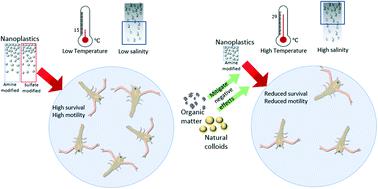当前位置:
X-MOL 学术
›
Environ. Sci.: Nano
›
论文详情
Our official English website, www.x-mol.net, welcomes your feedback! (Note: you will need to create a separate account there.)
Toxicity of nanoplastics to zooplankton is influenced by temperature, salinity, and natural particulate matter
Environmental Science: Nano ( IF 7.3 ) Pub Date : 2022-06-23 , DOI: 10.1039/d2en00123c Tiago F. Lins 1 , Anna M. O'Brien 2 , Talha Kose 1 , Chelsea M. Rochman 2 , David Sinton 1
Environmental Science: Nano ( IF 7.3 ) Pub Date : 2022-06-23 , DOI: 10.1039/d2en00123c Tiago F. Lins 1 , Anna M. O'Brien 2 , Talha Kose 1 , Chelsea M. Rochman 2 , David Sinton 1
Affiliation

|
Plastic pollution is ubiquitous and understanding its environmental effects is a matter of urgency. Nanoplastics (NPs) are the smallest class of plastic pollution, and may elicit more detrimental biological effects than larger plastic particles. However, nanoplastic toxicity may depend on variable environmental parameters, such as temperature, salinity and the presence of other particulate matter—a parameter set too large for conventional toxicity measurement approaches. We applied a high-throughput approach to examine toxic effects of NPs on A. franciscana across 112 combinations of temperature (three levels, 15–29 °C), salinity (four levels, 35–261 g L−1 salts), and particulate matter (humic acids or natural colloids at 5 g L−1, or none) and NP particles (4 levels, 0–100 mg L−1). The influence of experimental conditions on toxicity to A. franciscana strongly depended on NP surface charge. We did not observe any effects from negatively charged NPs over 48 hours. There was not any mortality caused by positively charged NPs below 100 mg L−1 at room temperature (22 °C), but there was decreased survival and motility by more than 50% at higher salinities and warmer temperature. The extent to which natural particulates mitigated nanoplastic toxicity to A. franciscana (up to 20%), and the retention of NPs inside A. franciscana were also temperature- and salinity-dependent. In sum, we found nanoplastic toxicity to A. franciscana varies greatly across ecologically relevant ranges of temperature and salinity, highlighting the importance of environmental conditions to nanoplastic effects on this species. Our findings hinged on the combinatorial experimental treatments that our automated system enabled, demonstrating the power of high-throughput platforms for ecotoxicology.
中文翻译:

纳米塑料对浮游动物的毒性受温度、盐度和天然颗粒物的影响
塑料污染无处不在,了解其对环境的影响是当务之急。纳米塑料 (NPs) 是最小的塑料污染类别,与较大的塑料颗粒相比,它可能会引起更有害的生物效应。然而,纳米塑料的毒性可能取决于可变的环境参数,例如温度、盐度和其他颗粒物的存在——对于传统的毒性测量方法来说,这个参数集太大了。我们应用高通量方法在 112 种温度(三个水平,15–29 °C)、盐度(四个水平,35–261 g L -1盐)和颗粒物组合中检查 NPs 对A. franciscana的毒性作用物质(腐殖酸或天然胶体,5 g L -1,或无)和 NP 颗粒(4 个水平,0–100 mg L -1)。实验条件对A. franciscana毒性的影响很大程度上取决于 NP 表面电荷。我们在 48 小时内没有观察到带负电的 NP 的任何影响。在室温(22°C)下,低于 100 mg L -1的带正电的 NP 不会导致任何死亡,但在较高的盐度和较高的温度下,存活率和运动性降低了 50% 以上。天然颗粒减轻纳米塑料对A. franciscana的毒性的程度(高达 20%),以及 NPs 在A. franciscana内的保留也与温度和盐度有关。总之,我们发现纳米塑料对A. franciscana在与生态相关的温度和盐度范围内变化很大,突出了环境条件对纳米塑料对该物种的影响的重要性。我们的研究结果取决于我们的自动化系统启用的组合实验处理,证明了高通量平台在生态毒理学方面的强大功能。
更新日期:2022-06-23
中文翻译:

纳米塑料对浮游动物的毒性受温度、盐度和天然颗粒物的影响
塑料污染无处不在,了解其对环境的影响是当务之急。纳米塑料 (NPs) 是最小的塑料污染类别,与较大的塑料颗粒相比,它可能会引起更有害的生物效应。然而,纳米塑料的毒性可能取决于可变的环境参数,例如温度、盐度和其他颗粒物的存在——对于传统的毒性测量方法来说,这个参数集太大了。我们应用高通量方法在 112 种温度(三个水平,15–29 °C)、盐度(四个水平,35–261 g L -1盐)和颗粒物组合中检查 NPs 对A. franciscana的毒性作用物质(腐殖酸或天然胶体,5 g L -1,或无)和 NP 颗粒(4 个水平,0–100 mg L -1)。实验条件对A. franciscana毒性的影响很大程度上取决于 NP 表面电荷。我们在 48 小时内没有观察到带负电的 NP 的任何影响。在室温(22°C)下,低于 100 mg L -1的带正电的 NP 不会导致任何死亡,但在较高的盐度和较高的温度下,存活率和运动性降低了 50% 以上。天然颗粒减轻纳米塑料对A. franciscana的毒性的程度(高达 20%),以及 NPs 在A. franciscana内的保留也与温度和盐度有关。总之,我们发现纳米塑料对A. franciscana在与生态相关的温度和盐度范围内变化很大,突出了环境条件对纳米塑料对该物种的影响的重要性。我们的研究结果取决于我们的自动化系统启用的组合实验处理,证明了高通量平台在生态毒理学方面的强大功能。


























 京公网安备 11010802027423号
京公网安备 11010802027423号